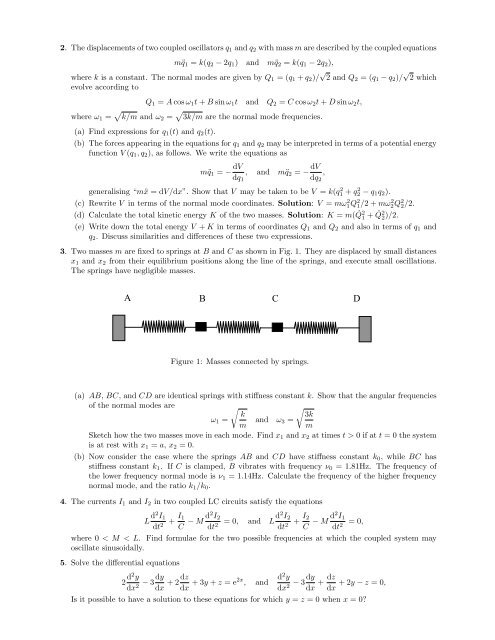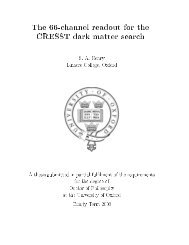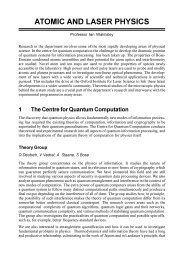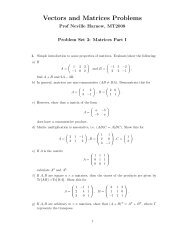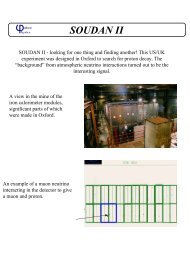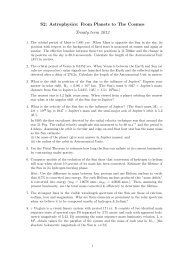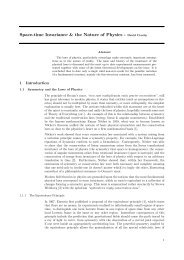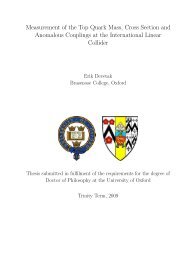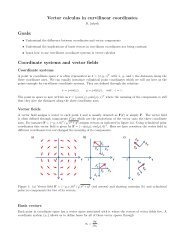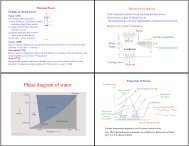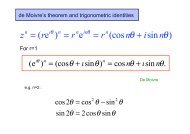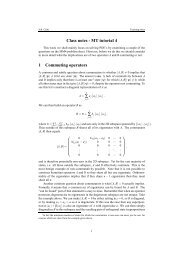Normal Modes Goals: Additional Resources: Problems:
Normal Modes Goals: Additional Resources: Problems:
Normal Modes Goals: Additional Resources: Problems:
Create successful ePaper yourself
Turn your PDF publications into a flip-book with our unique Google optimized e-Paper software.
2. The displacements of two coupled oscillators q 1 and q 2 with mass m are described by the coupled equations<br />
m¨q 1 = k(q 2 − 2q 1 ) and m¨q 2 = k(q 1 − 2q 2 ),<br />
where k is a constant. The normal modes are given by Q 1 = (q 1 + q 2 )/ √ 2 and Q 2 = (q 1 − q 2 )/ √ 2 which<br />
evolve according to<br />
Q 1 = A cos ω 1 t + B sin ω 1 t and Q 2 = C cos ω 2 t + D sin ω 2 t,<br />
where ω 1 = √ k/m and ω 2 = √ 3k/m are the normal mode frequencies.<br />
(a) Find expressions for q 1 (t) and q 2 (t).<br />
(b) The forces appearing in the equations for q 1 and q 2 may be interpreted in terms of a potential energy<br />
function V (q 1 , q 2 ), as follows. We write the equations as<br />
Two equal masses m are connected as shown with two identical massless<br />
springs, of spring constant k. Considering<br />
m¨q 1 = − dV only motion<br />
, and m¨q 2 = − dV in the vertical direction,<br />
,<br />
obtain the differential equations dq for 1 the displacements dq 2 of the two masses from<br />
their equilibrium positions. Show that the angular frequencies of the normal<br />
modes are given by<br />
generalising “mẍ = dV/dx”. Show that V may be taken to be V = k(q 2 1 + q 2 2 − q 1 q 2 ).<br />
(c) Rewrite V in terms of the normal mode coordinates. Solution: V = mω 2 1Q 2 1/2 + mω 2 2Q 2 2/2.<br />
2<br />
! = ±<br />
( )<br />
3 5 k / 2m<br />
(d) Calculate the total kinetic energy K of the two masses. Solution: K = m( ˙Q 2 1 + ˙Q 2 2)/2.<br />
(e) Write<br />
Find<br />
down<br />
the<br />
the<br />
ratio<br />
total<br />
of<br />
energy<br />
the amplitudes<br />
V + K in terms<br />
of the<br />
oftwo coordinates<br />
masses<br />
Qin 1<br />
each<br />
and Qseparate 2 and also<br />
mode.<br />
in terms of q 1 and<br />
q 2 . Discuss similarities and differences of these two expressions.<br />
Why does the acceleration due to gravity not appear in these answers?<br />
3. Two masses m are fixed to springs at B and C as shown in Fig. 1. They are displaced by small distances<br />
x 1 5. and x 2 *AB, from their BC, equilibrium and CD are positions identical alongsprings the line with of thenegligible springs, andmass, execute and small stiffness oscillations.<br />
The springs have negligible masses.<br />
constant k:<br />
A B C D<br />
Figure 1: Masses connected by springs.<br />
(a) AB, BC, and CD are identical springs with stiffness constant k. Show that the angular frequencies<br />
of the normal modes are<br />
The masses m, fixed to the springs √ at B and C, are √ displaced by small distances<br />
k 3k<br />
x 1 and x 2 from their equilibrium ω 1 = positions along the line of the springs, and<br />
m and ω 3 =<br />
m<br />
execute small oscillations. Show that the angular frequencies of the normal<br />
modes are !<br />
1<br />
= k / m and !<br />
2<br />
= 3 k / m . Sketch how the two masses move in<br />
each mode. Find x 1 and x 2 at times t > 0 if at t = 0 the system is at rest with<br />
x 1 = a, x 2 = 0.<br />
Sketch how the two masses move in each mode. Find x 1 and x 2 at times t > 0 if at t = 0 the system<br />
is at rest with x 1 = a, x 2 = 0.<br />
(b) Now consider the case where the springs AB and CD have stiffness constant k 0 , while BC has<br />
stiffness constant k 1 . If C is clamped, B vibrates with frequency ν 0 = 1.81Hz. The frequency of<br />
the lower frequency normal mode is ν 1 = 1.14Hz. Calculate the frequency of the higher frequency<br />
normal mode, and the ratio k 1 /k 0 .<br />
6. *The setup is as for question 5, except that in this case the springs AB and CD<br />
have stiffness constant k 0 , while BC has stiffness constant k 1 . If C is clamped, B<br />
vibrates with frequency ν 0 = 1.81 Hz. The frequency of the lower frequency<br />
L d2 I 1<br />
normal mode dt 2 is + I 1<br />
ν 1 C= − 1.14 M d2 I 2<br />
dt Hz. 2 = Calculate 0, and I 2<br />
the Ld2 dtfrequency 2 + I 2<br />
C − M d2 I 1<br />
of dt the 2 = higher 0, frequency<br />
normal mode, and the ratio k 1 /k 0 . (From French 5-7).<br />
4. The currents I 1 and I 2 in two coupled LC circuits satisfy the equations<br />
where 0 < M < L. Find formulae for the two possible frequencies at which the coupled system may<br />
oscillate sinusoidally.<br />
7. Two particles 1 and 2, each of mass m, are connected by a light spring of<br />
stiffness k, and are free to slide along a smooth horizontal track. What are the<br />
normal 2 d2 y<br />
frequencies of this system? Describe the motion in the mode of zero<br />
dx<br />
frequency. 2 − 3 dy<br />
dx + 2 dz<br />
dx + 3y + z = d 2 y<br />
e2x , and<br />
dx<br />
Why does a zero-frequency mode appear 2 − 3 dy<br />
dx + dz + 2y − z = 0,<br />
dx<br />
in this problem, but not in<br />
question 5, for example?<br />
5. Solve the differential equations<br />
Is it possible to have a solution to these equations for which y = z = 0 when x = 0?<br />
Particle 1 is now subject to a harmonic driving force F cos!t . In the steady


